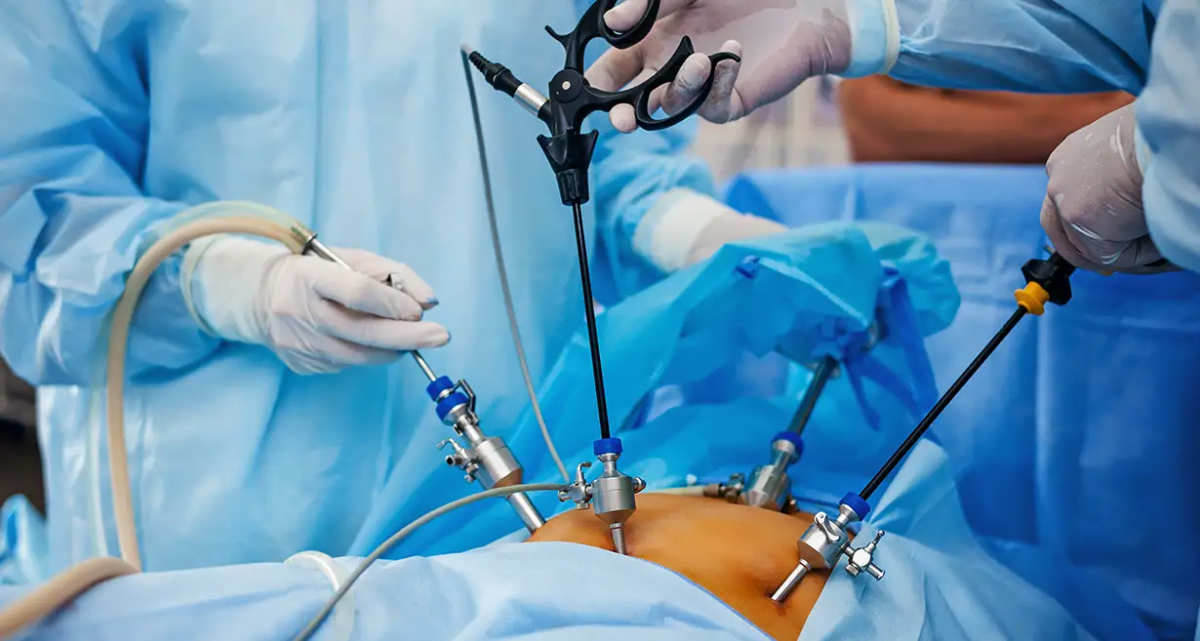Reading Time: 3 minutes
What is Laparoscopy?

Introduction
In recent years, the field of surgery has witnessed significant advancements, with laparoscopy emerging as a revolutionary technique. Laparoscopy, also known as keyhole surgery or minimally invasive surgery, has transformed the field of surgical procedures by offering numerous benefits to patients. In this article, we will explore laparoscopy-
- Its applications,
- Advantages,
- Limitations, and
- How it has revolutionized the field of surgery.
What is Laparoscopy?
Laparoscopy involves the use of specialized surgical instruments and a laparoscope—a long, thin, and flexible tube equipped with a high-resolution camera—to visualize and operate on the internal organs. It requires only small incisions, typically less than half an inch, through which the laparoscope and other instruments are inserted into the body.
The Laparoscopic Procedure
During a laparoscopic procedure, the surgeon first creates small incisions near the surgical site. Carbon dioxide gas is then introduced to inflate the abdominal cavity, creating space for better visualization and maneuvering. The laparoscope is inserted through one of the incisions, providing a magnified, real-time view of the surgical area on a monitor.
Using specialized instruments, the surgeon performs the necessary surgical steps, guided by the visual feedback from the laparoscope. The instruments are manipulated externally by the surgeon, who uses precise movements to perform the required procedures. At the end of the surgery, the gas is released, and the small incisions are closed with sutures or adhesive strips.
Advantages of Laparoscopy
- Reduced Scarring: The small incisions used in laparoscopy result in minimal scarring compared to traditional open surgery. This is particularly beneficial for patients concerned about cosmetic outcomes.
- Faster Recovery: Laparoscopic procedures typically result in shorter hospital stays and quicker recovery times. The reduced trauma to the body allows for faster healing and a quicker return to normal activities.
- Less Pain: Laparoscopy causes less post-operative pain compared to open surgery, leading to reduced reliance on pain medications and a more comfortable recovery period.
- Lower Risk of Infection: The smaller incisions in laparoscopy reduce the risk of surgical site infections, minimizing complications and improving patient outcomes.
- Improved Cosmesis: The smaller incisions and reduced scarring contribute to improved cosmesis, enhancing patient satisfaction and self-esteem.
Applications of Laparoscopy
Laparoscopy has a wide range of applications across various medical specialties. Some common procedures performed using laparoscopy include:
- Laparoscopic Cholecystectomy: Removal of the gallbladder for conditions such as gallstones.
- Laparoscopic Appendectomy: Removal of the appendix in cases of appendicitis.
- Laparoscopic Hysterectomy: Removal of the uterus for conditions like fibroids or certain gynecological cancers.
- Laparoscopic Hernia Repair: Repair of hernias through small incisions, reducing the risk of post-operative complications.
- Laparoscopic Colon Resection: Removal of parts of the colon for conditions such as colorectal cancer or diverticulitis.
- Laparoscopic Nephrectomy: Removal of the kidney, often performed for kidney cancer or living donor kidney transplantation.
- Laparoscopic Bariatric Surgery: Weight loss procedures such as sleeve gastrectomy or gastric bypass can be performed laparoscopically, offering the benefits of reduced scarring and quicker recovery.
Limitations/ Challenges of Laparoscopy
While laparoscopy has many applications and advantages, it also has certain limitations/ challenges-
- Loss of tactile sense, such as the margins and staging– This can be helped by the use of laparoscopic ultrasound and hand-assisted techniques.
- Limited access and instrumentation– This can be solved by hand-assisted maneuvers and improved retractors.
- Bleeding control– While always a significant threat with the organs, can be addressed with devices such as the harmonic scalpel, the vascular stapler and other such devices.
- Gas embolism– But this passes with time.
Future Perspectives
The future of laparoscopy is promising, with ongoing research and technological advancements aimed at further improving surgical outcomes. Miniaturization of instruments, increased availability of robotic platforms, and the integration of artificial intelligence and virtual reality into laparoscopic procedures are areas of active exploration.
Conclusion
Laparoscopy has transformed the field of surgery, offering patients a minimally invasive alternative to traditional open surgery. With its numerous advantages, including reduced scarring, faster recovery, and less post-operative pain, laparoscopy has improved patient outcomes and satisfaction. The applications of laparoscopy span across various medical specialties, enabling surgeons to perform complex procedures with precision and efficiency. As technology continues to advance, laparoscopy is expected to play an increasingly significant role in the future of surgical interventions, bringing about further advancements and improved patient care.
